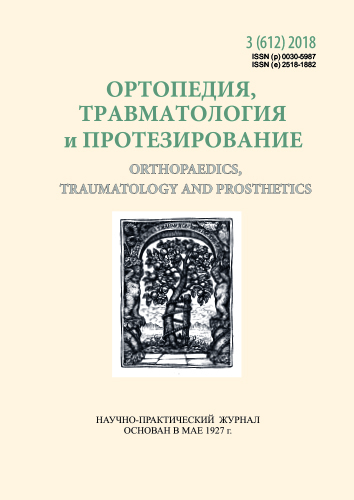Frequency of osteoporosis and fractures in patients with spine and spinal cord injuries
DOI:
https://doi.org/10.15674/0030-59872018345-49Keywords:
osteoporosis, fracture, paraplegia, tetraplegia, spine trauma, spinal cord traumaAbstract
An increase in the life expectancy of patients with spine and spinal cord injuries leads to an increased risk of late complications, such as osteoporosis and fractures due to low-energy trauma.
Objective: to determine the incidence of osteoporosis and fractures in individuals with spine and spinal cord injuries.
Methods: 137 patients with spine and spinal cord injuries (90 men and 47 women) were examined with duration of the post-traumatic period from 3 months up to 38 years with complete transverse spinal cord injury and 137 individuals in the comparison control group. The bone mineral density was determined.
Results: in patients with spine and spinal cord injuries and duration of the post-traumatic period less than 5 years, osteoporosis was detected in 40.6 % of cases, and in the comparison group normal bone mineral density was recorded (DI: 28.4–51.1; χc2 = 37.4; p < 0.0001). With an increase in the post-traumatic period for more than 5 years, osteoporosis or low bone mineral density has been revealed (in women of reproductive age and men younger than 50 years). In the comparison group, osteoporosis was not diagnosed, and a low bone mineral density was detected in 10 persons (3 men, 7 women). Among patients with spine and spinal cord injuries, the fracture rate was 18.2 % — 25 (10 men, 15 women). The average duration of the post-traumatic period at the time of the fracture was (9.7 ± 7.8) years. In the comparison group, fractures were significantly less common in 2 (1.5 %) patients (χc2 = 21.4; p < 0.0001; DI: 10.0–24.0). A significantly greater prevalence of fractures was observed in patients with spinal cord injury at the level of the lumbar spine (39.3 %) than cervical and thoracic — 11.1 % (χс2 = 5.4; p < 0.05; DI: 3.1–37.1) and 13.7 % (χс2 = 4.2; p < 0.05; DI: 0.8–34.7) respectively. The incidence of fractures increased with increasing duration of the post-traumatic period.
Conclusions: the high incidence of osteoporosis and fractures in individuals with spine and spinal cord injuries causes specific preventive and curative measures to improve their bone tissue.
References
- Fehlings, M., Singh, A., Tetreault, L., Kalsi-Ryan, S., & Nouri, A. (2014). Global prevalence and incidence of traumatic spinal cord injury. Clinical Epidemiology, 309. doi:https://doi.org/10.2147/clep.s68889
- Slynko, E. I. (2005) Urhentna neirokhirurhichna dopomoha pry uskladnenii khrebetno-spynnomozkovii travmi na Ukraini (prohramna dopovid). Ukrainskyi neirokhirurhichnyi zhurnal, 3, 63–74. (in Ukrainian)
- Bryson, J. E., & Gourlay, M. L. (2009). Bisphosphonate use in acute and chronic spinal cord injury: a systematic review. The Journal of Spinal Cord Medicine, 32(3), 215–225. doi:https://doi.org/10.1080/10790268.2009.11760776
- Hammond, E. R., Metcalf, H. M., McDonald, J. W., & Sadowsky, C. L. (2014). Bone mass in individuals with chronic spinal cord injury: associations with activity-based therapy, neurologic and functional status, a retrospective study. Archives of Physical Medicine and Rehabilitation, 95(12), 2342–2349. doi:https://doi.org/10.1016/j.apmr.2014.07.395
- Sabour, S. (2017). Dual-energy X-ray absorptiometry and fracture prediction in patients with spinal cord injuries and disorders: methodological issues. Osteoporosis International, 28(7), 2259–2259. doi:https://doi.org/10.1007/s00198-017-3990-7
- Troy, K. L., Morse, L. R. (2015) Measurement of bone: diagnosis of sci-induced osteoporosis and fracture risk prediction. Topics in Spinal Cord Injury Rehabilitation, 21(4), 267–274. doi: https://doi.org/10.1310/sci2104-267
- Gifre, L., Vidal, J., Carrasco, J., Portell, E., Puig, J., Monegal, A., … Peris, P. (2013). Incidence of skeletal fractures after traumatic spinal cord injury: a 10-year follow-up study. Clinical Rehabilitation, 28(4), 361–369. doi:https://doi.org/10.1177/0269215513501905
- Frotzler, A., Cheikh-Sarraf, B., Pourtehrani, M., Krebs, J., & Lippuner, K. (2015). Long-bone fractures in persons with spinal cord injury. Spinal Cord, 53(9), 701–704. doi:https://doi.org/10.1038/sc.2015.74
Downloads
How to Cite
Issue
Section
License
Copyright (c) 2018 Maryna Bystrytska

This work is licensed under a Creative Commons Attribution 4.0 International License.
The authors retain the right of authorship of their manuscript and pass the journal the right of the first publication of this article, which automatically become available from the date of publication under the terms of Creative Commons Attribution License, which allows others to freely distribute the published manuscript with mandatory linking to authors of the original research and the first publication of this one in this journal.
Authors have the right to enter into a separate supplemental agreement on the additional non-exclusive distribution of manuscript in the form in which it was published by the journal (i.e. to put work in electronic storage of an institution or publish as a part of the book) while maintaining the reference to the first publication of the manuscript in this journal.
The editorial policy of the journal allows authors and encourages manuscript accommodation online (i.e. in storage of an institution or on the personal websites) as before submission of the manuscript to the editorial office, and during its editorial processing because it contributes to productive scientific discussion and positively affects the efficiency and dynamics of the published manuscript citation (see The Effect of Open Access).














